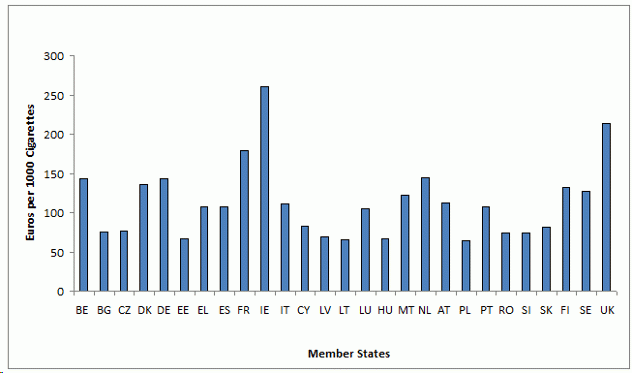The World Health Organization's Framework Convention on Tobacco Control (WHO 2003), the world's first public health treaty, calls for parties to the treaty to implement evidence-based tobacco control policies and programmes to reduce tobacco use. Adopted in May 2003 and entered into force in February 2005, 171 countries representing more than 80% of the world's population are currently parties to the treaty. Yet while the treaty provides the broad framework for tobacco control, it is the protocols and guidelines negotiated by the members that provide the detailed guidance for implementing the treaty's provisions. Increases in tobacco excise taxes are central to the treaty, but to date no such protocols or guidelines for its implementation have been developed.
Tobacco taxes
While governments apply a wide variety of taxes on tobacco products, it is the taxes unique to tobacco products (tobacco excise taxes) that most directly influence the relative prices of tobacco products and, as a result, have the greatest impact on tobacco use. Historically the primary objective of tobacco taxes has been revenue generation but as evidence has accumulated about the health and economic consequences governments have increasingly used higher tobacco taxes as a means to discourage its use.
Excise taxes can take two forms – specific (per unit) taxes or ad valorem (value-based) taxes. Globally, cigarette excise tax structures vary considerably, with some governments applying relatively simple tax structures that impose the same specific or ad valorem rate on all cigarettes, while others adopt more complex multi-tiered structures that impose different rates on cigarettes with different characteristics (e.g. price, length, presence of filter, and/or other factors), and still others use a combination of specific and ad valorem taxes (WHO 2010).
Choosing the best tobacco tax – the theory
Economic theory indicates that the choice of tobacco excise tax structure will have a significant impact on a government's ability to achieve its objectives (WHO 2010). Uniform specific taxes on cigarettes are relatively easy to administer. In contrast, price-based multi-tiered specific taxes and ad valorem taxes can be more difficult administratively, requiring some determination of value (which can be subject to manipulation) and therefore also requiring strong tax administration in order to deter tax avoidance. The real value of specific taxes will erode over time unless tax rates are regularly adjusted for inflation in contrast to ad valorem taxes which will rise with prices (similarly, ad valorem taxes will decline with price cuts); both, however, need to be increased to reduce affordability of tobacco products.
The revenues generated by ad valorem taxes are more sensitive to industry pricing decisions than revenues generated by specific taxes. This is because industry price changes result in greater changes in retail prices given the multiplicative nature of an ad valorem tax. Moreover, the manipulative nature of ad valorem taxes associated with industry pricing decisions will increase with market concentration. As a result, ad valorem taxes can lead to tax erosion and instability of government revenues. Similarly, the multiplier effect of an ad valorem tax creates disincentives for the production of higher “quality” products when compared to a specific tax, leading to greater availability of relatively low priced, low “quality” products. Tax structures that use a mix of specific and ad valorem taxes incorporate the strengths and weaknesses of both types of excises, yet at the cost of adding to the administrative complexity.
Empirical evidence on tobacco tax structure
Empirical evidence on the impact of tobacco excise tax structure on key outcomes such as tobacco tax revenues and tobacco use is almost non-existent. Our recent paper (Chaloupka et al., 2010) begins to fill this gap by assessing the effects of differences in cigarette excise tax structure on cigarette prices, cigarette tax revenues, cigarette consumption, and smoking prevalence.
Using data on 21 EU countries from 1998 through to 2007, we take advantage of the variability in cigarette tax structure that results from the EU's directive on tobacco taxes. The directive:
- sets a minimum for cigarette taxes (both in absolute terms and as a percentage of price for the most popular brand category),
- requires a mix of specific and ad valorem excises, and
- provides a range for the share of the total tax that must be accounted for by the specific tax.
For example, for cigarettes in the most popular price category, the EU directive has required:
- a minimum tax of €64 per 1,000 cigarettes,
- the tax to comprise at least 57% of retail price,
- that specific taxes account for between 5% and 55% of the total tax.
As shown in Figures 1 and 2, this has resulted in considerable variability in absolute cigarette excise tax levels, the share of tax in price, and the share of cigarette excises accounted for by the specific tax.
Figure 1. Cigarettes, overall minimum excise duty
Source: European Commission, 2010. Notes: Abbreviations as follows: 27 countries: AT - Austria, BE - Belgium, BG - Bulgaria, CY - Cyprus, CZ - Czech Republic, DK - Denmark, EE - Estonia, FI - Finland, FR - France, DE - Germany, EL - Greece, HU - Hungary, IE - Ireland, IT - Italy, LV - Latvia, LT - Lithuania, LU - Luxembourg, MT - Malta, NL - Netherlands, PL - Poland, PT - Portugal, RO - Romania, SK - Slovakia, SI - Slovenia, ES - Spain, SE - Sweden, UK - United Kingdom
Figure 2. Cigarette, excise yield
Source: European Commission, 2010.
We find that greater reliance on specific excise taxes reduces the gap in prices between high- and low-priced cigarette brands, reducing opportunities for smokers to switch to cheaper brands in response to increases in taxes and prices, with a greater impact in less concentrated cigarette markets. Similarly, we find that average cigarette prices are higher in countries where the specific tax accounts for greater share of the total excise on cigarettes. As a result, we estimate that cigarette consumption is lower in countries that rely more on specific excises, as would be expected given our findings concerning the impact of tax structure on cigarette prices. In addition, we find that, for the same total excise tax, greater reliance on the specific tax is associated with higher cigarette excise tax revenues and less variability in these revenues over time, with instability in revenues greater in markets that are more concentrated.
Calling for a high, uniform specific tax
From a public health perspective, a strong argument can be made for a high, uniform specific tax on cigarettes as this tax sends the clear message that all cigarettes are equally harmful. Our estimates are consistent with this, showing that greater reliance on specific cigarette excises results in higher cigarette prices and lower cigarette consumption; at the same time, we demonstrate that such a tax structure is also effective in achieving revenue aims.
The greater public health impact of specific taxes was a key factor in the EU's new directive on tobacco taxes (Council of the European Union 2010) that raises the minimum taxes required of member states and increases emphasis on specific taxes. This is also reflected in the WHO's recent Technical Manual on Tobacco Tax Administration that includes simpler tax structures that rely more on specific taxes among its 'best practices' (WHO 2010).
We feel that our evidence is particularly timely; this November parties begin the process of developing clear standards for tobacco taxation under the WHO FCTC at the 4th Conference of the Parties in Uruguay.
References
Chaloupka FJ, Peck R, Tauras JA, Xu X, Yurekli A (2010). Cigarette Excise Taxation: The Impact of Tax Structure on Prices, Revenues, and Cigarette Smoking. NBER Working Paper 16287.
Council of the European Union (2010). Council Directive 2010/12/EU. Brussels: European Commission.
European Commission (2010). Excise Duty Tables. Part III - Manufactured Tobacco, July 2010. Brussels: European Commission.
World Health Organization (2003). Framework Convention on Tobacco Control. Geneva: World Health Organization.
World Health Organization (2010). WHO Technical Manual on Tobacco Tax Administration. Geneva: World Health Organization.








